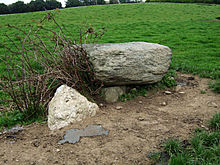|
|
|
|
Letter (site E)Dolmen / Quoit / Cromlech
|
||||||||||||||||||||||||
|
|
|
Images (click to view fullsize) |
|









|
Fieldnotes |
|
|
A typically impressive disc, set on the southern valley slope of the Argideen river; over two metres in diameter and almost a metre thick. The measurements provided by the Archaeological Inventory for the immediate area are: Caherkirky - 2.4m by 2.2m; 1m thick / 1.7m by 1.3m; 0.8m thick Knocks (East) - 1.8m by 1.7m; 0.9m thick / 2.4m by 2.4m; 0.6m thick / 2m by 1.3m; 0.65m thick Letter - 2.3m by 2.1m; 0.8m thick One almost wonders if there was a form of Bronze Age grading in effect - an upper limit beyond which the stones would prove too cumbersome and a lower limit to ensure an impact on the landscape. The only significant deviations from this size are in the boulders accompanying the stone circles around Kealkil, although similarly connected sites, such as Gurteen and Kenmare, further north in Kerry, have the typical stand-alone dimensions: Mill Little - 1.5m by 1.3m; 1.25m thick / 1.9m by 1.5m; 1.3m thick / 1.35m by 0.85m; 0.9m thick Cappanaboul - 1.6m by 1.5m; 0.7m thick Breeny More - 1.4m by 1.35m; 0.5m thick / 1.3m by 0.8m; 0.7m thick / 1.8m by 1m; 0.8m thick / 1.7m by 1.2m; 0.9m thick Maughanaclea - 1.5m by 1.05m; 0.6m thick / 1.5m by 1m; 0.6m thick It's an interesting question - did these smaller monuments reflect local restrictions on availability of suitable stone, or was the construction more affected by other factors such as inter-site influence, or local tradition? Dr. William O'Brien's excavation at the Cooradarrigan boulder-burial uncovered intriguing evidence of a wedge-shaped post-surround, widening towards the entrance feature on the northern side, which was in turn 'blocked' by another post. The open side of the boulder-burial at Bohonagh was found to contain a stone socket with uprooted slab which the excavator, E.M. Fahy, proposed as defining an entrance gap to the north-west. Though possibly not a universal rule, the arrangement of support stones underneath the cover often leaves one side open, varying in orientation from monument to monument. The structure at Letter opens slightly west of north, tilted upwards like a cannon on just two forward supports, the western of which is further elaborated, double-portal fashion, by a large pyramidal quartz block. If a target was intended, it would seem to have faced directly toward a broad rise in a valley, across the Argideen at Knockea. Visible on the western horizon, but not indicated, is the Carrigfadda range. Three letters (M/A/T) are roughly scribed on the western side; presumably an acronym or abbreviation left behind by someone as a mark of their presence and noted by Jack Roberts in his 1988 survey. The owners of this site, which can be easily accessed from an adjacent farmyard, live in the bungalow at the south-eastern corner of the field. Archaeological Inventory of Cork 1992, No.125; 32 Fahy, E., 'A Stone Circle, Hut and Dolmen at Bohonagh, Co. Cork', JCHAS 66, 1961; 94 O'Brien, W., 'Boulder-Burials: A Later Bronze Age Megalith Tradition in South-West Ireland', JCHAS 97, 1992; 11-35 O'Nuallain, S., 'Boulder-Burials', PRIA 78 C, No.22; 92 Roberts, J., 'Exploring West Cork', 1988; Ch.1. No.21; 35 |
 Posted by gjrk
Posted by gjrk30th September 2008ce Edited 13th December 2008ce |
Miscellaneous |
|
|
The term used for this class of monument; 'Boulder-Burial', is not exactly a misnomer although no human remains were found by Dr. William O'Brien in his excavation of three sites at Ballycommane and Cooradarrigan (dated from charcoal fragments to 1426-1266 BC). A token amount of cremated bone was found in the Bohonagh excavation and the acidic soil conditions may have been sufficient to destroy any similar evidence at the former three sites. I tend to think, though, that there is a sort of graceful beauty and fit to Somerville's suggestion, borrowed from the North-West of Ireland, of 'Clochtogle/Clach Tógáil' or 'Lifted Stone'. Fahy, E., 'A Stone Circle, Hut and Dolmen at Bohonagh, Co. Cork', JCHAS 66, 1961; 94 O'Brien, W., 'Boulder-Burials: A Later Bronze Age Megalith Tradition in South-West Ireland', JCHAS 97, 1992; 11-35 Somerville, B.T., 'Prehistorics', JCHAS 33, 1928; 66 |
 Posted by gjrk
Posted by gjrk30th September 2008ce |

